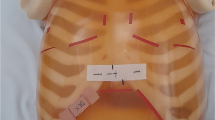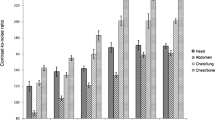Abstract
We evaluated the potential for reduction of dose to the female breast in computed tomography (CT) of the thorax by using three different techniques: bismuth shielding, partial CT scanning and tube-current modulation (TCM). Measurements and simulations of dose and image quality were performed for a 64-slice CT system using a semi-anthropomorphic thorax phantom with breasts added. Three-dimensional dose distributions were calculated by Monte Carlo (MC) methods. Noise was determined by measurements and simulations. Bismuth shielding resulted in a dose reduction of about 50% for the breast, noise increased up to 40% and image quality was impaired by artifacts. In partial CT scans, not irradiating the breasts directly, dose to the breasts was reduced typically by 50%. To sustain a constant noise level, an increase of irradiation in the anteroposterior position resulted in a higher dose to the spine. Reduction of dose to the breasts of about 10% was achieved with TCM; distribution of noise was homogeneous and image quality uniform. Reduction of dose to the female breast was achieved by using all adapted CT methods. Bismuth shielding may compromise image quality, increase noise level and introduce streak artifacts. Partial and TCM examinations reduced dose to the breast without influencing image quality.





Similar content being viewed by others
References
American Cancer Society (2006) Cancer facts and figures 2006. American Cancer Society, Atlanta
Tokunaga M, Land CE, Yamamoto T (1987) Incidence of female breast cancer among atomic bomb survivors, Hiroshima and Nagasaki, 1950–1980. Radiat Res 112:243–272
Boice JD, Monson RR (1977) Breast cancer in women after repeated fluoroscopic examinations of the chest. J Natl Cancer Inst 59:823–832
Shore RE, Hempelmann LH, Kowaluk E (1977) Breast neoplasms in women treated with x-rays for acute postpartum mastitis. J Natl Cancer Inst 59:813–822
International Commission on Radiological Protection (ICRP) (1991) 1990 Recommendations of the International Commission on Radiological Protection. ICRP Publication 60, Ann ICRP 21(1–3). Pergamon Press Oxford
International Commission on Radiological Protection (ICRP) (2008) Recommendations of the ICRP. ICRP Publication 103, Ann ICRP 37(2–3). Elsevier, Oxford
Geleijns J, Salvado Artells M, Veldkamp WJ, Lopez Tortosa M, Calzado Cantera A (2006) Quantitative assessment of selective in-plane shielding of tissues in computed tomography through evaluation of absorbed dose and image quality. Eur Radiol 16:2334–2340
McLaughlin DJ, Mooney RB (2004) Dose reduction to radiosensitive tissues in CT. Do commercially available shields meet the users’ needs? Clin Radiol 59:446–450
Schmidt B, Kalender WA (2002) Zusammenhang zwischen Reduktion der Patientendosis und des Röhrenstom-Zeit-Produktes bei unterschiedlichen Arten der Röhrenstrommodulation bei CT-Untersuchungen. Fortschr Röntgenstr VO52.3
Schmidt B. Dosisberechnungen für die Computertomographie (2001) In: Kalender WA (ed) Berichte aus dem Institut für Medizinische Physik. Bd. 7. Shaker, Aachen
Kalender WA, Wolf H, Süß C, Gies M, Greess H, Bautz WA (1999) Dose reduction in CT by on-line tube current control: principles and validation on phantoms and cadavers. Eur Radiol 9:323–328
Kalender WA (2005) Computed tomography, 2nd edn. Publicis, Erlangen
Greess H, Nömayr A, Wolf H et al (2002) Dose reduction in CT examination of children by an attenuation-based on-line modulation of tube current (CARE dose). Eur Radiol 12:1571–1576
Kalra MK, Maher MM, Toth TL et al (2004) Strategies for CT radiation dose optimization. Radiology 230:619–628
Graser A, Wintersperger BJ, Suess C, Reiser MF, Becker CR (2006) Dose reduction and image quality in MDCT colonography using tube current modulation. AJR Am J Roentgenol 187:695–701
Mulkens TH, Daineffe S, De Wijngaert R et al (2007) Urinary stone disease: comparison of standard-dose and low-dose with 4D MDCT tube current modulation. AJR Am J Roentgenol 188:553–562
Ulzheimer S, Kalender WA (2003) Assessment of calcium scoring performance in cardiac computed tomography. Eur Radiol 13:484–497
McCollough CH, Ulzheimer S, Halliburton SS, Shanneik K, White RD, Kalender WA (2007) Coronary artery calcium: a multiinstitutional, multimanufacturer international standard for quantification at cardiac CT. Radiology 243:527–538
Kalender WA, Rienmüller R, Behr J, Seißler W, Fichte H, Welke M (1990) Quantitative CT of the lung with spirometrically controlled respiratory status and automated evaluation procedures. In: Fuchs W (ed) Advances in CT. Springer, Heidelberg, pp 85–93
Deak P, van Straten M, Shrimpton PC, Zankl M, Kalender WA (2007) Validation of a Monte Carlo tool for patient-specific dose simulations in X-ray computed tomography. Eur Radiol (in press)
Schmidt B, Kalender WA (2002) A fast voxel-based Monte Carlo method for scanner- and patient- specific dose calculations in computed tomography. Physica Medica XVIII(2)
Mulkens TH, Bellinck P, Baeyaert M et al (2005) Use of an automatic exposure control mechanism for dose optimization in multi-detector row CT examinations: clinical evaluation. Radiology 237:213–223
Acknowledgements
This work was financially supported by the EC-EURATOM 6 Framework Program (2002–2006) and forms part of the “Safety and Efficacy of Computed Tomography (CT): A broad perspective” project (contract no. FP/002388).
We also would like to thank Tanja Gagliardi, M.D., Inselspital Bern, for fruitful discussions, inspirations and support with this topic.
Many thanks to our colleagues Paul Deak, Oliver Langner and Michael Knaup from the Institute of Medical Physics in Erlangen for their support in dose calculations, dose measurements and image reconstruction.
Author information
Authors and Affiliations
Corresponding author
Rights and permissions
About this article
Cite this article
Vollmar, S.V., Kalender, W.A. Reduction of dose to the female breast in thoracic CT: a comparison of standard-protocol, bismuth-shielded, partial and tube-current-modulated CT examinations. Eur Radiol 18, 1674–1682 (2008). https://doi.org/10.1007/s00330-008-0934-9
Received:
Revised:
Accepted:
Published:
Issue Date:
DOI: https://doi.org/10.1007/s00330-008-0934-9




